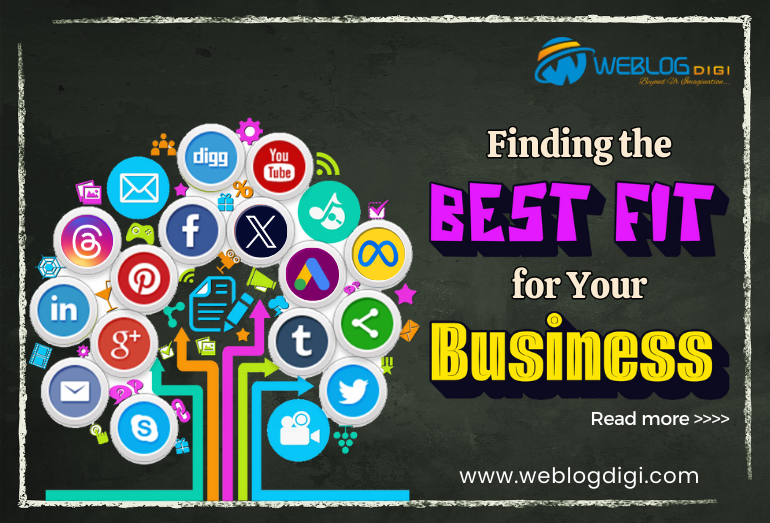Digital Marketing Platforms: Finding the Best Fit for Your Business

In today’s digital age, choosing the right Digital Marketing Platforms can be a game-changer for your business. With numerous platforms offering a variety of features, selecting the one that aligns with your business goals, budget, and target audience is crucial. In this blog, we’ll compare leading Digital Marketing Platforms to help you determine the best fit for your business.
Platforms for Digital Marketing:
We use a variety of digital marketing platforms for various purposes. We select platforms based on our objectives. If you want to reach a large number of people, you should use social media. Blogging and content marketing are excellent tools for building a brand.
Here are some of the top digital marketing platforms that we use:
Google Ads
Strengths
Search Dominance: Google Ads taps into Google’s vast search network, enabling businesses to target users who are actively searching for related products or services.
Advanced Targeting: Offers robust targeting options, including keywords, demographics, and location.
Performance Tracking: Provides detailed analytics and performance tracking for precise campaign adjustments.
Weaknesses
Cost: This can be expensive, particularly for competitive keywords.
Complexity: Requires a steep learning curve for effective campaign management.
Best For
Businesses seeking to capture high-intent search traffic and those with a sufficient budget for competitive bidding.
Facebook Ads
Strengths
Audience Reach: Facebook’s massive user base allows extensive reach across various demographics.
Ad Formats: Offers diverse ad formats such as carousel, video, and lead generation ads.
Detailed Targeting: Allows specific audience targeting based on interests, behaviours, and demographics.
Weaknesses
Declining Organic Reach: Organic reach on Facebook has decreased, making paid ads more essential for visibility.
Ad Fatigue: Users may experience ad fatigue due to high ad density.
Best For
Brands aim to build awareness, engage with a broad audience, and utilize visual and interactive ad formats.
Instagram Ads
Strengths
Visual Appeal: Instagram’s visually oriented platform is ideal for brands with strong visual content.
Engagement Rates: These platforms typically have higher engagement rates than other social media platforms.
Integration with Facebook: Utilise Facebook’s effective targeting capabilities.
Weaknesses
Ad Costs: This can be costly, particularly for competitive niches.
Limited Click-Through Options: Direct links are generally limited to ads and profile bios.
Best For
Businesses with visually compelling products and services, such as fashion, food, travel, and lifestyle brands.
LinkedIn Ads
Strengths
Professional Network: LinkedIn is the go-to platform for B2B marketing, offering access to a professional audience.
Targeting by Job Title: Allows targeting based on job titles, industries, and company sizes.
Lead Generation: Effective for generating high-quality B2B leads through sponsored content and E-Mail.
Weaknesses
Cost: Typically more expensive than other social media marketing options.
Limited User Base: Smaller user base compared to other platforms like Facebook or Instagram.
Best For
B2B companies looking to target professionals, decision-makers, and industry leaders.
Twitter Ads
Strengths
Real-Time Engagement: Ideal for real-time marketing and engaging with current events and trending topics.
Hashtag Targeting: Allows for precise reach to niche audiences by targeting them using hashtags.
Ad Variety: Provides different types of ads, such as promoted tweets and trends.
Weaknesses
Short Content Lifespan: Tweets have a short lifespan, requiring frequent posting and engagement.
Lower Conversion Rates: This platform generally has lower conversion rates compared to other platforms.
Best For
Brands focusing on real-time engagement, trend participation, and quick, concise messaging.
YouTube Ads
Strengths
Video Content: Use the power of video, which has a high engagement and retention rate.
Massive Reach: Access to YouTube’s extensive user base across various demographics.
SEO Benefits: Videos can improve SEO, increasing visibility on both YouTube and Google search results.
Weaknesses
Production Costs: High-quality video production can be costly and time-consuming.
Ad Skipping: Users can skip ads after a few seconds, reducing full view rates.
Best For
Brands with compelling video content looking to reach a broad audience and enhance their SEO efforts.
Conclusion
Selecting the right Digital Marketing Platforms depends on your specific business goals, target audience, budget, and content type. Google Ads and Facebook Ads are versatile options suitable for most businesses, while Instagram and YouTube excel in visual content. LinkedIn is ideal for B2B marketing, and Twitter is perfect for real-time engagement. Evaluate your needs, leverage the strengths of each platform, and create a balanced and effective digital marketing strategy to drive your business forward.
Contact our Digital Marketing Experts for more information on choosing Digital Marketing Platforms, determining which platform is best for your business, and how to make it work for you. I appreciate you reading this post.
Contact Us:
https://www.weblogdigi.com/contact-us/ to get started on your digital marketing journey.
